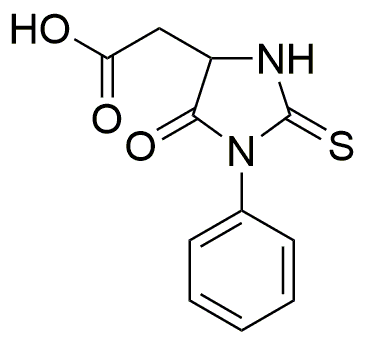Phenylthiohydantoin-aspartic acid is widely utilized in research focused on:
- Peptide Synthesis: This compound serves as a key reagent in the synthesis of peptides, helping researchers create specific sequences for studies in biochemistry and molecular biology.
- Protein Characterization: It is used in the identification and characterization of proteins, particularly in determining amino acid sequences, which is crucial for understanding protein function and interactions.
- Drug Development: The compound plays a role in pharmaceutical research, aiding in the design of new drugs by providing insights into molecular interactions and stability.
- Diagnostics: It is applied in diagnostic assays, particularly in the detection of specific proteins or biomarkers, enhancing the accuracy of medical tests.
- Research on Enzyme Activity: The compound is utilized in studies examining enzyme kinetics and mechanisms, offering valuable data for enzymology research.
Informations générales
Propriétés
Sécurité et réglementation
Applications
Phenylthiohydantoin-aspartic acid is widely utilized in research focused on:
- Peptide Synthesis: This compound serves as a key reagent in the synthesis of peptides, helping researchers create specific sequences for studies in biochemistry and molecular biology.
- Protein Characterization: It is used in the identification and characterization of proteins, particularly in determining amino acid sequences, which is crucial for understanding protein function and interactions.
- Drug Development: The compound plays a role in pharmaceutical research, aiding in the design of new drugs by providing insights into molecular interactions and stability.
- Diagnostics: It is applied in diagnostic assays, particularly in the detection of specific proteins or biomarkers, enhancing the accuracy of medical tests.
- Research on Enzyme Activity: The compound is utilized in studies examining enzyme kinetics and mechanisms, offering valuable data for enzymology research.
Documents
Fiches de données de sécurité (FDS)
La FDS fournit des informations de sécurité complètes sur la manipulation, le stockage et l’élimination du produit.
Spécifications du produit (PS)
Le PS fournit une description complète des propriétés du produit, notamment sa composition chimique, son état physique, sa pureté et les exigences de stockage. Il détaille également les plages de qualité acceptables et les applications prévues du produit.
Certificats d'analyse (COA)
Recherchez des certificats d'analyse (COA) en saisissant le numéro de lot du produit. Les numéros de lot et de lot se trouvent sur l'étiquette d'un produit, après les mots « Lot » ou « Lot de fabrication ».
Numéro de catalogue
Numéro de lot/série
Certificats d'origine (COO)
Ce certificat d'exploitation confirme le pays dans lequel le produit a été fabriqué, et détaille également les matériaux et composants utilisés et s'il est issu de sources naturelles, synthétiques ou autres sources spécifiques. Ce certificat peut être requis pour les douanes, le commerce et la conformité réglementaire.
Numéro de catalogue
Numéro de lot/série
Fiches de données de sécurité (FDS)
La FDS fournit des informations de sécurité complètes sur la manipulation, le stockage et l’élimination du produit.
DownloadSpécifications du produit (PS)
Le PS fournit une description complète des propriétés du produit, notamment sa composition chimique, son état physique, sa pureté et les exigences de stockage. Il détaille également les plages de qualité acceptables et les applications prévues du produit.
DownloadCertificats d'analyse (COA)
Recherchez des certificats d'analyse (COA) en saisissant le numéro de lot du produit. Les numéros de lot et de lot se trouvent sur l'étiquette d'un produit, après les mots « Lot » ou « Lot de fabrication ».
Numéro de catalogue
Numéro de lot/série
Certificats d'origine (COO)
Ce certificat d'exploitation confirme le pays dans lequel le produit a été fabriqué, et détaille également les matériaux et composants utilisés et s'il est issu de sources naturelles, synthétiques ou autres sources spécifiques. Ce certificat peut être requis pour les douanes, le commerce et la conformité réglementaire.


